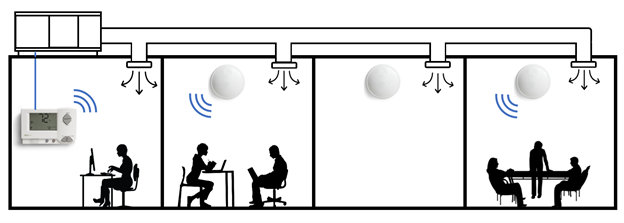 Project Title
Project Title
Occupancy-based Thermostat for Commercial Offices
Project Number ET17SDG8031 Organization SDG&E End-use HVAC Sector Commercial Project Year(s) 2017 - 2020In small to medium sized offices, spaces are commonly conditioned by a single-zone HVAC unit with one thermostat in the control zone. However, a zone can consist of multiple spaces, making it difficult to meet the individual comfort needs of each space. Therefore, single-zone units in commercial buildings are typically left on for the entire duration of building operating hours to guarantee adequate ventilation and temperature control, regardless of zone occupancy. Thus, there is a potential for energy savings if the unit can determine zone occupancy and respond by reducing or eliminating the delivery of heating, cooling, and ventilation to the zone when it is vacant.
The emerging technology studied in this report, a thermostat connected to lighting occupancy sensors, is one such device that allows an HVAC unit to respond to zone occupancy. The thermostat is connected to one or more occupancy sensors and collects occupancy information from the spaces served by the unit. The technology responds to the zone occupancy by modifying thermostat settings, such as setting back temperature setpoints or turning off the HVAC unit if the zone is deemed unoccupied. The technology is commonly installed in hotels and motels where guest rooms are often left unoccupied for extended periods of time. The technology works well in hotel guest rooms because the HVAC system configuration is often simple: one space per zone and a thermostat that directly controls the HVAC unit’s operation (i.e. no BMS).
